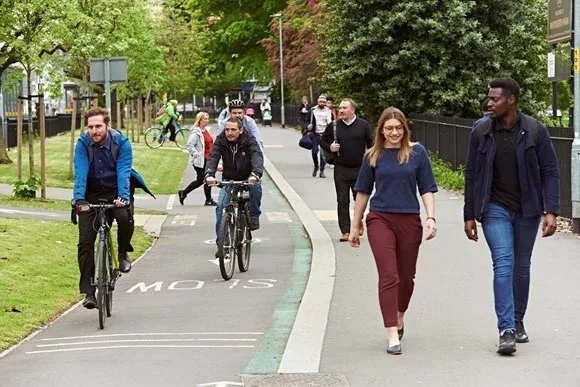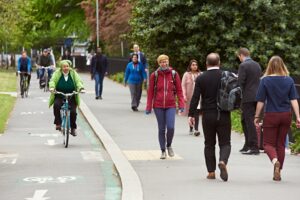We know that walking, cycling, and using scooters are great for our health. But did you know that choosing these forms of ‘active travel’ over cars can also significantly reduce carbon emissions and help combat climate change?
Transport is a major contributor to greenhouse gas emissions, and switching to active travel for shorter journeys can make a big difference. As the Department for Transport notes, achieving a 60% CO2 reduction in the UK’s domestic transport sector by 2030 requires real and early changes in travel behavior. Make your trips environmentally friendly – Sustrans.org.uk
Consider this:
- Reduce car use: “Policies that reduce overall vehicle use and increase walking and cycling will yield the greatest benefits in terms of reductions in greenhouse gas emissions and air pollution and the health advantages of increased physical activity,” according to The Lancet Countdown on health and climate change.
- Lower emissions: CO2 emissions per passenger for train and coach are, on average, six to eight times lower than car travel. Trains also produce about one-third of the CO2 emissions of a plane. Make your trips environmentally friendly – Sustrans.org.uk
- Short trips matter: In the UK, about 3 out of 5 car trips are under 8 km (5 miles), producing 21% of car CO2 emissions. Active Travel’s Contribution to Climate Change Mitigation: Research Summary and Outlook
Developing Active Travel Atitude
Developing an “active travel attitude” involves making walking, cycling, and scooting the natural choice for journeys. This requires creating safe and connected infrastructure like dedicated cycle lanes and well-maintained footpaths, alongside educating the public through skills training and road safety awareness. Incentives and motivation such as “Cycle to Work” schemes and workplace initiatives can further encourage participation, while shifting social norms through community events and visible role models helps normalize active travel. Ultimately, it’s a multi-faceted approach combining practical improvements with strong encouragement to foster a culture where active travel is the preferred way to get around.
Small Conclusion
By choosing to walk, cycle, or scoot for our daily commutes, errands, and leisure activities, we can collectively make a substantial impact on reducing carbon emissions and creating a healthier, more sustainable future.


